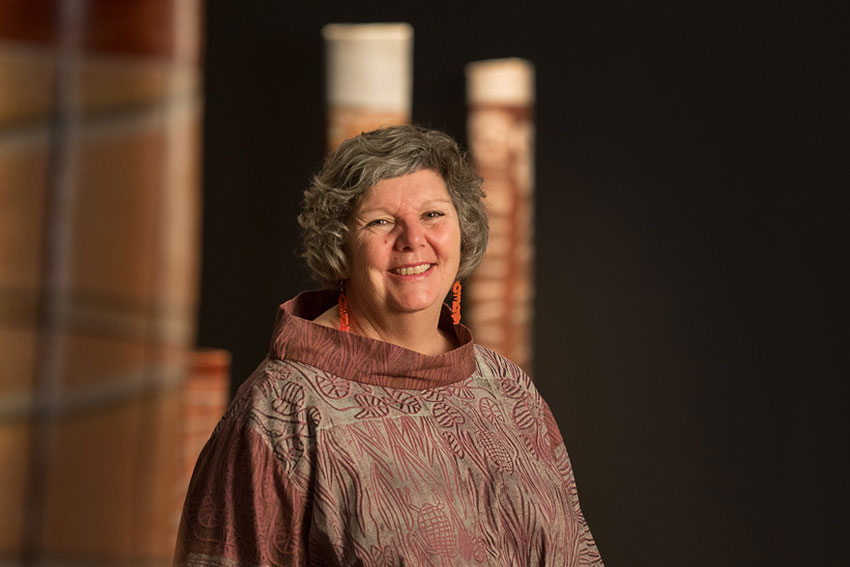
Walter Marsh
Walter is a writer and editor living on Kaurna Country.

As artistic director of Tarnanthi, Nici Cumpston works at the forefront of contemporary Aboriginal and Torres Strait Islander art. But her own artistic practice tells another compelling story, as Cumpston explores the entwined relationship of Australia’s river systems and Aboriginal communities.
“I work on Country, photographing and walking around sites of occupation of Aboriginal people, evidence in the landscape of where Aboriginal people have lived and where important sites are, for mainly my own family,” Cumpston tells The Adelaide Review. “I’m Barkindji, we’re from the Barka, we’re the people of the river from far western New South Wales. I’ve photographed in and around the Darling River but also the Murray River, because ancestrally Barkindji people were associated with all the inland lakes travelling down from Mutawintji National Park all the way down through to the Darling River which then joins with the Murray at Wentworth. Then, travels through all of South Australia’s inland lake systems down to Kumarangk or Goolwa at the Murray Mouth.”
In exploring the river systems of the Murray Darling basin, Cumpston’s work highlights both the deep ties between Indigenous communities and Australia’s water ways, and how government mismanagement can result in the erasure of both Country and culture. “Part of what I’ve been doing with my photographic practice is travelling those waterways and recording sites and just taking my time,” she says. “I’m really conscious of how as Aboriginal people our voices historically haven’t been heard, so this is a way for me to give voice to our stories and to talk about the environment and our concerns for the way the river systems are being mismanaged. I’m really interested in bringing our ancestral voice into the current day, and portraying that through the works of art that I’m creating.”

One site, Nookamka Lake in the Riverland, is of particular importance to Cumpston, and the subject of Oh my Murray Darling, a photographic work that is currently a finalist in the 2019 Telstra National Aboriginal & Torres Strait Islander Art Awards. This year’s finalists also includes 18 South Australian artists, from Adelaide-based Damien Shen to APY Lands artists like Kaylene Whiskey, Witjiti George and Nyunmiti Burton, who The Adelaide Review spoke to in May.
“This is a place that I visit a lot, I frequently go up to Barmera in the Riverland and I walk this lake. I take my time, I go early morning or late in the afternoon, to all different sites in the lake,” she says of the area depicted in Oh my Murray Darling. “And it’s alive, you can almost hear the ancestors when you’re there. It’s a really powerful place, and at the moment it’s in a really good condition, the lake itself, but a few years ago the flow of fresh water in to the lake was stopped as a result of the drought, and the federal government deciding not to allow any fresh water into the lakes, because they needed to keep it all within the Murray River.
“Those trees in my image, that are dead in the water, are a result of the locks and the weirs being put in for irrigation, for farming – that particular waterway, that became a much more expanded area.” The trees, she explains, mark the lake’s original waterline, and the site of historic Aboriginal campsites that for years lay hidden beneath the water. “When the water receded, you could walk around and see the evidence of Aboriginal occupation, through the scar trees, the ring trees, the middens that were exposed. I feel that archaeologically these stories are rich for all Australians to know and understand our connection as Aboriginal people to these places.

“But that hasn’t happened at this point; there’s all sorts of connections for us as Aboriginal people to this country that have been eroded, and also desecrated through the lack of recognition of the importance of these sites. There’s all sorts of histories and knowledges that are being destroyed without people realising what it is that they’re destroying.”
The power of photography as a medium for capturing the changes in Australia’s river system is well-established, from old black and white images of the ancient Brewarrina fish traps on the Barwon River in New South Wales to the more recent images of mass fish deaths that drew national attention to the sickness of our river systems.
“It’s all-encompassing isn’t it?” Cumpston says of photography. “It’s about what we can see through the lens of a camera, but for me it’s [also] about evoking emotion into those images, and being able to give people a sense of the importance of these places. It’s a chance for me to talk to the deeper richer stories that are embedded within that image, that without it I wouldn’t be able to tell.”

“This particular image (Oh my Murray Darling) was created last year at a time when the lake was starting to come back to life,” she says. “I guess the reasoning behind creating the Rorschach image and the mirror of itself was about showing the tension that is just below the surface, that it’s not all sweet and smooth. There are all sorts of underlying issues for Aboriginal people living in that area, not only for Aboriginal people but all people that live there, and how their livelihood is really tethered to the health of the lake.”
And while her day job as Art Gallery of South Australia curator and Tarnanthi artistic director keeps her busy working with Aboriginal and Torres Strait Islander artists from around the country (“I feel empowered by all the artists around me, and I feel like we’re a force to be reckoned to with,” she says), her own work remains an integral part of her life.
“I can’t stop making work no matter how busy I am,” she says. “It’s in there, and these stories need to be told. I feel like I’ve got something to say.”
Winners of the 36th Telstra National Aboriginal & Torres Strait Islander Art Awards will be announced on Friday, August 9
magnt.net.au/natsiaa
Tarnanthi: Festival of Contemporary Aboriginal and Torres Strait Islander Art
October 18 – 27
agsa.sa.gov.au

Walter is a writer and editor living on Kaurna Country.